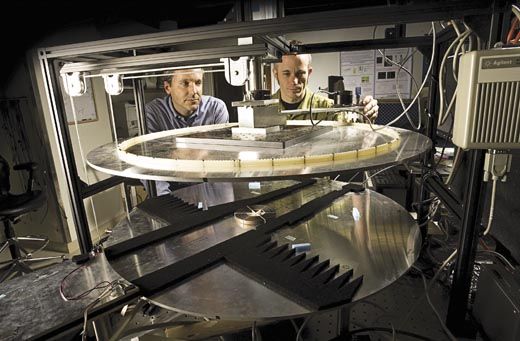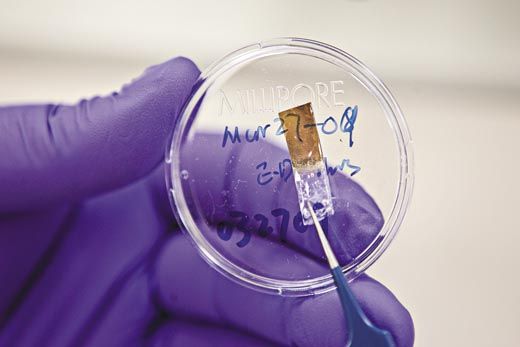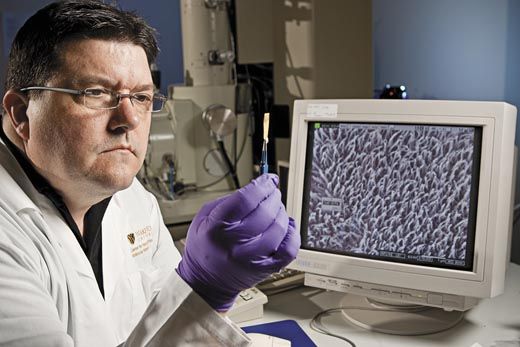Now You See It, Now You Don’t
Blinding us with science: the next generation of stealth.
/https://tf-cmsv2-smithsonianmag-media.s3.amazonaws.com/filer/Today_Stealth_Flash_ON09.jpg)
Look down a long stretch of highway on a summer afternoon and in the distance a pool of water seems to wait for you, glistening under the hot sun. It’s only an illusion—Mother Nature’s version of a practical joke. The difference in density between the asphalt-heated air near the surface and the cooler air above acts like a lens, bending light waves as they pass from one layer to the next to reflect the blue sky and hide both the blacktop and any vehicles at the far end of the road behind a shimmering curtain.
Scientists and engineers are trying to emulate that trick by designing materials that could constitute the next-next (or next-next-next) generation of stealth. Some of their ideas sound like they sprang from the imaginations of Gene Roddenberry or J.K. Rowling, with phrases like “cloaking device” and “invisibility carpet” popping up as frequently in academic papers as in television scripts and books for kids. Other ideas are more realistic, as researchers devise ways to change an aircraft’s color and blur its outline, confusing the bad guys enough to make them shoot in the wrong direction.
“If someone would have asked me three or four years ago, I would have said there’s no science in this—it’s all sci-fi,” says Vladimir Shalaev, a professor of electrical and computer engineering at Indiana’s Purdue University and leader of a group that has designed a microscopic cloaking device. “It’s still very challenging, but it’s a huge, huge breakthrough to realize that light can behave in such unusual ways that, with certain limitations, objects could become invisible.”
Not an entire bomber or fighter, mind you—not for a long time, anyway. While researchers have built small cloaking devices in the laboratory and designed others on computers, light is still too tricky for the whole spectrum of colors to be controlled at once.
“You have to choose the frequencies—the bands over which you’re going to be stealthy,” says David Carroll, director of the Center for Nanotechnology at Wake Forest University in North Carolina. “An aircraft or a car or other vehicle can have signatures on many, many different levels. Sometimes the signatures are in the infrared, because the object is hot. Sometimes they are signatures in the visible, because you can see it. Sometimes they are sound signatures, like an M1 tank—you can hear it.”
Over the years, aircraft designers have experimented with ways to mask all of these signatures. The ideas have made modern-day fighters and bombers practically disappear from radar screens, chilled their hot exhaust gases, and even muffled the growl of their engines. So far, though, the most effective way of shielding aircraft from enemy fire has been to camouflage them by painting them black and flying them at night.
Future stealth is also based on camouflage, through agile coloration—a chameleon-like paint that senses the surrounding environment and changes its color to blend in. “It will sense where the sky is, what the color of the sky is, what the contrast is, and then change its own appearance by feeding back into itself, like a chameleon would do,” says Carroll. “These smart coatings don’t add a great deal of weight to the aircraft. So I think we’ll see, probably in the next 20 years, airplanes that change color.”
The agile paints that Carroll’s group and others are studying are based on electrochromic materials, which change color when an electric charge passes through them. Such materials are already in everyday use. In the rearview mirrors of many cars, for example, an electrochromic compound is sandwiched between layers of glass to prevent bright headlights from dazzling a driver. As the headlights shine on the mirror, they create an electric charge that darkens the electrochromic layer. Carroll’s agile paints contain microscopic particles of silver, which grab or lose electrons as an electric current flows past; as the paint’s electric charge is altered, its color changes.
A related technology could blur the edges of an aircraft, making it harder for a person on the ground to precisely plot its position. Researchers jokingly call it the Predator Effect—named not for the drone aircraft, but for the creature from the movie Predator. As the being swung through the jungles of Central America, it bedeviled commandos by turning almost invisible. The creature was transparent, its outline faintly visible, making it almost impossible for the commandos to attack it.
Researchers are examining ways to blur an aircraft’s outline by using a recently created branch of nanotechnology known as meta-materials. Ordinary metals, plastics, and other materials are combined in a way that alters their response to light, heat, radio waves, and other forms of electromagnetic radiation. In particular, researchers discovered that meta-materials can bend light in ways that no naturally occurring material can do—even backward. It’s that ability that could allow a coating of meta-materials to smear an airplane’s outline.
The effectiveness of meta-materials depends on their ability to manipulate a property of matter known as the refractive index, which is a measure of how much a beam of electromagnetic radiation bends when passing from one medium into another, such as from air to water. If you look at a straw in a glass of water, for example, the part of the straw in the water looks like it’s bent at a different angle from the part in the air, and it looks closer to you than it really is. That’s because when a beam of light crosses the boundary between two materials with different refractive indexes, the beam changes speed and direction. The greater the difference in the refractive indexes of the two materials, the greater the change in speed and direction. This property is what makes eyeglass lenses work. As light passing through the air strikes the surface of a lens, it is bent to a new path; if the lens is shaped properly, all of the light rays come to focus at a desired point in the eyes.
Researchers realized that meta-materials could act as superlenses by drastically altering the paths of light, microwaves, and other forms of electromagnetic energy. At their extreme, meta-materials, which consist of tiny bits of specially shaped metals layered with plastics or other materials that are poor conductors of electricity, can have a negative index of refraction, which means they can bend light so that it travels backward.
In a 2006 paper published in the journal Science, Scottish physicist John Pendry and two collaborators at Duke University in North Carolina suggested a dramatic possibility for such materials: cloaking. By manipulating the properties of light, “these fields can be focused as required or made to avoid objects and flow around them like a fluid, returning undisturbed to their original trajectories,” Pendry wrote. In other words, a meta-material object could bend the light from the background around to the front, so the object itself would be hidden in an electromagnetic cloak.
Steven Cummer, a Duke electrical and computer engineering professor, is part of the meta-materials research team that built and tested a cloaking device prototype in 2006. It consists of a copper ring surrounded by a shell of 10 layers of a meta-material in which precisely shaped copper patterns are imprinted on a layer of non-conducting material, in this case fiberglass. The team fired a beam of microwaves at the cloaking device and measured both the beam’s reflection and the microwave “shadow” the device cast. Each layer of shell bent the beam at a slightly different angle, curving it completely around the five-inch test ring. The result? The copper ring—and the cloaking device itself—was completely hidden.
“The shell took the electromagnetic energy and smoothly bent it around [the copper ring] in the interior, and then bent it back to fill in the shadow region [the space behind the object being cloaked],” says Cummer. “Those are the two things that dictate making something invisible. If you can fill in the shadow and get rid of the reflection, that’s what it takes.”
While the experiment proved that meta-materials could cloak an object, it was only a small-scale demonstration. What’s more, it was limited to microwaves, which are the type of radio waves used in radar. Cloaking an object in visible light is much tougher, because there is a relationship between the length of the wave to be deflected and the size of the individual elements in the cloaking device: the smaller the wavelength, the smaller the elements of the meta-materials must be. Microwaves are thousands of times longer than waves of visible light, so a visible-light cloak requires meta-material components that are as small as a few millionths of an inch across. And even if such tiny structures could be manufactured, the metal in them would absorb light waves more efficiently than microwaves, so less of the light would be deflected around the object.
Yet Purdue’s Shalaev says that cloaking an object in visible light is not impossible. In 2007, his group designed a visible-light cloaking device. Like the Duke experiment, it consisted of a central ring encircled by meta-materials. In this case, though, instead of a shell of concentric rings, the meta-material consists of tiny wires that radiate from the central ring like the bristles of a round hairbrush. In theory, Shalaev says, the device would deflect light around the ring, making it completely hidden from view. “You create an area where light cannot enter, and it flows around that area in such a way that it looks like nothing is there—like empty space,” he says.
There are problems with the design, though. First, because different wavelengths of light are refracted at different angles (which is why shining a beam of light through a glass prism creates a rainbow), the cloak is limited to a single wavelength—in this case, red. And second, Shalaev and his team have not yet met the technical challenges required to build the device.
Even so, Shalaev says they have already thought about ways to build a broader cloak to cover a wider spectrum of colors. “The idea is that there are several cloaks hidden one inside of the other, and each of them works for its own wavelength,” he says. To explain the concept, he conjures an image from his native Russia: “It’s kind of like a matryoshka, where one doll is sitting inside of another doll.”
Unfortunately, each doll adds weight.
“This is mathematically pretty simple, and you could put it on an airplane and your airplane would disappear, but only at the narrow frequency of your cloak,” says Carroll. “So if I have an F-22, and I want to make it disappear to the visible range, I’m going to have to have a lot of layers. The material that we’re talking about is almost solid metal, which means I just added a ton to the airframe, and that’s not going to work very well.”
But if cloaking won’t work in three dimensions, perhaps it will work in two.
In January, Duke researchers reported a successful test of an invisibility “carpet.” They placed a meta-material cloak atop a reflective metal surface with a significant bump protruding from the otherwise flat surface. When the researchers aimed a microwave beam at the test rig, the bump was hidden—the microwaves behaved as if they reflected directly off of a flat, bump-free surface beneath the cloak.
While the test cloak was carefully shaped to minimize its own microwave reflection and shadow, the researchers suggested that the technique eventually could be used to hide objects from detection in both microwaves and visible light. “In essence, you’re hiding the bump by masking it with the cloaking layer, and making the combination of the cloak and the bumpy surface look like a flat surface,” says Cummer, who did not participate in the test.
Cloaking an entire airplane may never happen, at least not with the materials and techniques currently under development. Yet advances in meta-materials may yield smaller applications that could keep pilots and their aircraft safer and improve life for the rest of us: shielding electronics against lasers, microwaves, and other forms of radiation, coating adjacent radio towers so their signals don’t interfere with one another, developing computer circuits that switch on and off by using light waves instead of electricity, and many others.
It’s not exactly Harry Potter’s cloak, but it’s no mirage either.
Damond Benningfield is a freelance science and technology writer and radio producer in Austin, Texas.



